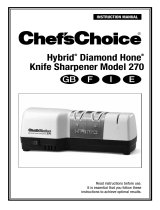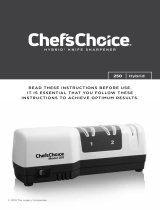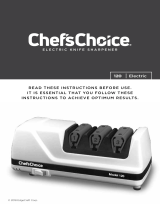ZWILLING J.A. Henckels 13551-002 Guía del usuario
- Tipo
- Guía del usuario

Cutlery Safety Information
For obvious reasons, knife safety is of utmost
importance. Avoid injuries by following practical knife
safety rules:
Keep knives sharp!
A sharp knife is safer than a dull one because
it requires less pressure in cutting. The knife
will not slip as easily and your hand will not tire
as quickly.
Never test the sharpness of a knife by running
your finger along the edge!
Use the correct size and type of knife for the job.
Knives come with dierent blade styles; each
style is designed to best perform a specific
task.
Use the right cutting board or surface.
Wooden or bamboo cutting boards or quality
polyethylene boards are recommended.
Make sure that knives laying on flat surfaces
are never covered with towels, napkins or other
materials.
After handling a knife, lay it down in a cleared
area, with the blade and point away from the
body, and away from the edge of the table or
cutting area.
Do not reach blindly for a knife.
Reach deliberately for the handle. When
handing a knife to another person, do so with
the handle toward him or her.
Only walk with your knife when absolutely
necessary.
When walking with a knife, carry it in your less
dominant hand (if you are right handed, carry
in your left hand, and vice versa) and keep the
knife close to your side, trying not to swing
you’re arm as you walk.
Never try to catch a falling knife!
Sharp knives should be washed separately.
Do not wash with other utensils. Each knife
should be dried separately, always keeping the
sharp cutting edge away from the hand. Dry
the knife blades from the back to the cutting
edge.
Do not store knives loose in a drawer!
Keep knives stored in a knife block or an
in-drawer knife tray when not in use. If using
a magnetic holder, make sure magnets are
strong enough to hold knives securely in place
and the knives are clean. A greasy knife will not
adhere properly to a magnetic rack.
Keep knives safely out of the reach of children.
ZWILLING J.A. HENCKELS WARRANTY
All HENCKELS INTERNATIONAL products are fully
guaranteed against defects in materials and / or
craftsmanship.
The ZWILLING J.A. Henckels warranty does not cover
wear from normal use or any damage resulting from use
other than for its intended purpose.
Wood products (including wood handle knives) are not
covered by the warranty, as wood is a natural element
and thus cannot be guaranteed.
Any product that is felt to be defective needs to be
returned to the address below for inspection. Please
wrap carefully to insure points or edges do not cut
through mailing carton. Allow 4-6 weeks for handling
and be sure to include your full mailing address.
(No post oce box numbers please).
ZWILLING J.A. Henckels will examine the knives and if
there is a manufacturers defect will repair or replace
within 4 to 6 weeks. If you would like to speak to
someone at ZWILLING J.A. Henckels regarding your
knives please call customer service at:
1-800-777-4308 between 9:00am - 5:00 pm eastern
standard time. Defective items will be repaired or
replaced with similar item at the option of ZWILLING
J.A. Henckels.
Distributed by :
ZWILLING J.A. HENCKELS,LLC
Pleasantville, NY 10570
www.zwilling.com
No. 99900-576 • © 2015 ZWILLING J.A HENCKELS, LLC
Use and Care
Return Procedure
Included with the knives should be the following
information:
NAME
ADDRESS
EMAIL
DAYTIME PHONE
DESCRIPTION (Example: CLASSIC 4” Parer)
Care of Knives
No metal is completely “stainless”. Do not allow acidic
foods (lemon, mustard, tomato, etc.) to remain on the
blade after use. This might cause some slight tarnishing.
Should the blade show some signs of staining, use a
non-abrasive metal polish for cleaning.
All HENCKELS INTERNATIONAL knives are
dishwasher safe. However, we do not recommend
putting knives in the dishwasher. Banging against
other cutlery or pots and pans will nick the edge.
Also, high heat and detergent are not good for the
handle.
Instead wipe the knife clean in your sink with
a wet cloth and dish washing detergent. Dry
immediately. Dry from the back of the knife to the
edge.
Do not cut through bone with knives (except
cleavers). Do not use knives for poking, prying,
separating or cutting semi-frozen or frozen foods.
Do not use knives as screwdrivers or can openers.
This is not their designated purpose and may
result in bending or breaking the blade or edge of
the knife. ZWILLING J.A. Henckels warranty does
not cover misuse.
Cutting Board and Surfaces
Cutting surfaces should be:
• Smooth
• Easy to clean
• “Give” on contact with knife edge
ZWILLING J.A. Henckels recommends:
• Wooden or bamboo cutting boards
• Quality polyethylene boards
REMEMBER: All cutting boards and surfaces
should be cleaned thoroughly immediately
after use to avoid harmful bacteria growth. For
sanitary purposes keep separate boards for
meat, fish, poultry, and seafood.
Avoid surfaces that can dull or damage the knife:
• China
• Marble
• Granite
• Tile
• Formica
• Porcelain
• Stainless counter tops
• Glass
• Ceramics
Maintaining a Knife’s Edge
Knives do not stay sharp forever. If you examine a knife
under a microscope, you would see that the edge is
made up of thousands of small cutting teeth. Through
use, the fine teeth on the cutting edge will eventually
get misaligned, resulting in a dull knife. It is necessary
to realign the teeth on a regular basis to renew the
cutting edge; this is called honing.
A quality knife is easy to hone when you use a
HENCKELS INTERNATIONAL sharpening steel. Do not
hone serrated knives with steel. If a serrated knife
becomes dull it should be sharpened by a professional
or replaced.
Care of sharpening steel
• Store in dry place
• Clean knives before sharpening
• After use, wipe steel with dry cloth
How to Use a Sharpening Steel
IMPORTANT INFORMATION: The sharpening steel must
have a higher hardness factor than the knife to be
sharpened.
4 Steps to using a HENCKELS INTERNATIONAL
sharpening steel:
1. Hold sharpening steel point down on table or
cutting board. (Figure 1)
2. Angle between blade and steel should be
approximately 20 degrees. (Figure 2)
3. Pull knife down and across sharpening steel,
moving from the heel of the knife to the tip.
(Figure 3)
4. Repeat on the other side of the steel.
(Figure 4)
Repeat steps 3 and 4 five to ten times,
always alternating the right and left side of
the cutting edge.
NOTE: Speed is not important. It is most
important to maintain the angle and to hone
the full length of the cutting edge.
Proper Knife Storage
Knives have to be stored in a safe place, protecting the
cutting edge and guarding against injuries.
Wooden knife blocks
• The most popular and suitable storage system
for fine knives.
• The counter-top slant block oers easy access
and fits underneath kitchen cabinets.
• The size of the block varies with the number
of knives to be stored.
Most HENCKELS INTERNATIONAL blocks also
have a slot for kitchen shears.
Knife Sharpener
HENCKELS INTERNATIONAL knife sharpener can quickly
and easily restore the edge of all your knives.
The knife sharpener will not only hone the edge of the
knife but also regrind it.
1. Grip handle firmly (Figure 1)
2. Just pull 4 or 5 times in the direction of the
arrow (Figure 2)
IMPORTANT :
• Use only moderate force
• Keep knife straight
• Do not use for serrated knives
43
21
21
2015_safetycare_HI.indd 1 9/18/15 2:15 PM

Seguridad y Cuidado
de su Cuchillo
Información de Seguridad de la Cuchillería
Por razones obvias, la seguridad de la cuchillería es
sumamente importante. Evite heridas, siguiendo estas
reglas prácticas de seguridad de la cuchillería:
¡Mantenga los cuchillos afilados!
Un cuchillo afilado es más seguro que uno
desafilado porque requiere de menos presión
cuando estas cortando. El cuchillo no se
resbalará tan fácilmente y su mano no se
cansará tan rápidamente.
Usar el tamaño correcto y el cuchillo apropiado
para el trabajo.
Agarre el cuchillo firmemente en su mano y
corte lejos del cuerpo. Se debe usar una tabla
de cortar hecha de madera o de polietileno.
Superficies de acrílico, cerámica y otras
superficies duras son duros para un filo de
cuchillo porque ellas no “dan” con el filo.
Asegure que los cuchillos colocados en
superficies planas nunca se cubren con paños,
servilletas, u otros materiales.
Después de manejar un cuchillo, colócalo en
un área despejada, con el filo apuntado en
una dirección opuesta del cuerpo, y lejos de la
orilla de la mesa o área de cortar.
No alcance ciegamente un cuchillo.
Alcance deliberadamente el mango del
cuchillo. Cuando estés dando un cuchillo a
otra persona, hágalo con el mango del cuchillo
apuntado hacia él o ella.
Nunca trate de agarrar un cuchillo cuando se
está cayendo.
Cuchillos afilados se deben lavar por separado.
No se deben lavar con otros utensilios. Cada
cuchillo se debe secar por separado, siempre
manteniendo los filos lejos de la mano. Seque
los filos desde la parte posterior del filo.
¡No almacene cuchillos sueltos en una gaveta!
Mantenga los cuchillos en un bloque para
cuchillos o en una bandeja para cuchillos
cuando no están en uso. Si estas usando un
soporte magnético, asegurase de que los
imanes sean lo suficientemente fuertes para
mantener los cuchillos asegurados en su lugar
y que los cuchillos estén limpios. Un cuchillo
grasoso no se adherirá apropiadamente a un
estante magnético.
Mantenga cuchillos seguros y fuera del alcance
de los niños!.
¡Nunca pruebes la agudeza de un cuchillo,
corriendo el dedo hacia el filo!
GARANTIA HENCKELS INTERNATIONAL
Todo producto de HENCKELS INTERNATIONAL es
completamente garantizado contra defectos en
materiales y/o en la artesanía.
La garantía ZWILLING J.A. Henckels no cubre el
desgastamiento por uso diario o cualquier daño
resultando del uso fuera de la compra prevista.
Productos de madera (incluyendo mangos de madera
de cuchillos) no están cubiertos por la Garantía
ZWILLING J.A. Henckels, considerando que la madera
es un elemento natural y de ese modo, no puede ser
garantizada.
Cualquier producto cual se piensa ser defectuoso debe
ser devuelto a la dirección de abajo, para inspección.
Por favor de envolver el producto con cuidado para
asegurar que las puntas o los filos no cortan a través
de la caja de correo. Permita 4-6 semanas para el
manejo y asegurase de incluir su dirección de domicilio
completa. (Por favor, ningún número de casillero postal).
ZWILLING J.A. Henckels examinará los cuchillos y
si hay un defecto del fabricante, será reparado o
reemplazado dentro de 4 a 6 semanas. Si le gustaría
hablar con alguien en ZWILLING J.A. Henckels acerca
de sus cuchillos, deberías llamar al servicio del cliente
al: 1-800-777-4308 entre las 9:00am-5:00pm hora
estándar del este. Artículos defectuosos se repararán
o reemplazarán con un artículo similar a la opción de
ZWILLING J.A. Henckels.
Distribuido por:
ZWILLING J.A. HENCKELS, LLC
Pleasantville, NY 10570
www.zwilling.com
No. 99900-576 • © 2015 ZWILLING J.A HENCKELS, LLC
El Cuidado de Cuchillos
Un buen cuchillo es una buena inversión. Con el cuidado
apropiado, durará toda una vida.
Ningún metal es completamente inoxidable. No
permita que comidas acidas (limón, mostaza,
salsa de tomate, etc.) se queda en el filo, después
de uso. Esto puede causar algún deslustre. Si el
filo llega a demonstrar señas de manchas, use
un pulidor de metal no abrasivo para limpiarlo.
(Es igual para la cubertería inoxidable.) In
No corte hueso con los cuchillos (excepto con
cuchillos de carnicero). No use cuchillos para
clavar, apalancar, separar o cortar comidas semi-
congeladas o congeladas..
No maltrate los cuchillos como destornilladores
o como abrelatas. Este no es su propósito
diseñado y puede resultar en el doblamiento o
quebramiento del filo o la orilla del cuchillo. La
garantía de HENCKELS INTERNATIONAL no cubre
el maltrato.
Cómo Usar Una Chaira
INFORMACION IMPORTANTE: La chaira debe tener
un factor más duro que el cuchillo que se va a afilar.
Como los cuchillos Henckels están hechos de la más
alta calidad de acero endurecido por hielo, una Chaira
de HENCKELS INTERNATIONAL es requerida para
mantener un filo agudo.
4 Pasos para usar la Chaira HENCKELS
INTERNATIONAL:
1. Mantenga la punta de la Chaira hacia abajo en
la mesa o en la tabla de cortar. (Figura 1)
2. El ángulo entre el filo y el acero debe ser de
aproximadamente 20 grados. (Figura 2)
3. Deslice el cuchillo atreves de la Chaira, en un
arco leve. (Figura 3)
4. Repita en el otro lado del acero.
(Figura 4)
Repita los pasos 3 y 4 cinco a diez veces, siempre
alternando el lado derecho y el lado izquierdo del filo.
NOTA: La velocidad no es importante. Es más
importante mantener el ángulo y afilar todo lo largo del
filo.
El Almacenamiento Apropiado de los Cuchillos
Los cuchillos deberían ser almacenados en un lugar
seguro, protegiendo el filo y protegiéndose a uno contra
heridas.
• Bloques de madera para cuchillos
• El sistema de almacenamiento más popular y
apropiado para cuchillos finos.
• El bloque inclinado del mostrador de cocina
ofrece acceso fácil y encaja bien debajo de los
gabinetes de cocina.
• El tamaño del bloque varía con el número
de cuchillos necesitando almacenamiento.
La mayoría de los bloques HENCKELS
INTERNATIONAL también tiene una ranura para
las tijeras de cocina.
• Bandejas de madera para cuchillos
• Convenientes y seguros para el cliente quien
quiere las características de un bloque de
cuchillos y quiere almacenar los cuchillos en una
gaveta de cocina.
• La bandeja de gavetas para cuchillos
HENCKELS INTERNATIONAL, está diseñada
con la misma destreza como los bloques para
mostradores de cocina. Encaja fácilmente en la
mayoría de gavetas de cocina.
Afilador International
El Afilador HENCKELS INTERNATIONAL ligeramente y
fácilmente puede restaurar el filo de todos sus cuchillos.
El Afilador HENCKELS INTERNATIONAL va a triturar y
afilar el filo del cuchillo, tal como un afilador profesional
lo haría.
.
1. Sujete el mango del cuchillo firmemente.
(Figura 1)
2. Jale 4 o 5 veces hacia las direcciones de la
echa (Figura 2)
IMPORTANTE :
• Debe utilizar solo fuerza moderada
• Mantenga el cuchillo erguido en forma recta
• No utlizar en cuchillos de dientes serrados
21
Tabla y Superficies de Cortar
Superficies de cortar deberían ser:
• Lisas
• Fáciles de limpiar
• “Dar” cuando en contacto con el filo
ZWILLING J.A. Henckels recomienda superficies
cuales pueden ser limpiadas fácilmente y
mantenidas higiénicas:
• Tablas de cortar de madera
• Tablas de calidad de polietileno
RECORDATORIO: Toda tabla de cuchillería
debería ser minuciosamente limpiada después
de uso para evitar el crecimiento de bacteria
dañina.
• Evite superficies duras que puedem dañar el
cuchillo :
• China
• Porcelana
• Azulejo
• Mostradores de cocina inoxidables
• Formica
Afilando un Cuchillo
Los cuchillos no se quedan afilados para siempre.
Si examinas un cuchillo debajo de un microscopio,
verás que el filo esta hecho de miles de pequeños
dientes cortantes. Con el uso, los dientes finos del
filo, eventualmente se desalinean, resultando en un
cuchillo desafilado. Es necesario alinear los dientes, o
afilar el cuchillo, periódicamente para renovar el filo.
Un cuchillo de calidad es fácil de afilar cuando usas
la Chaira Internacional o Afilador Internacional
de HENCKELS INTERNATIONAl. No afile cuchillas
dentadas con acero o el Afilador TWIN®. Si una
cuchilla dentada se desafila, debería ser afilado por un
profesional.
Chaira HENCKELS INTERNATIONAL
• La dureza de Rockwell de 62 grados para
fácilmente afilar los cuchillos de HENCKELS
INTERNATIONAL
• Magnético para agarrar pequeñas partículas
removidas del filo del cuchillo
Cuidado del Chaira
• Almacenar en un lugar seco
• Limpiar cuchillos antes de afilarlos
• Después de uso, limpiar el acero con un paño
• seco
Procedimiento de Devolución
La siguiente información se debe incluir con los
cuchillos:
NOMBRE
DIRECCIÓN
EMAIL
NÚMERO DE TELÉFONO DE DÍA
Descripción (Ejemplo: Pelalegumbres Classic)
2015_safetycare_HI.indd 2 9/18/15 2:15 PM
-
 1
1
-
 2
2
ZWILLING J.A. Henckels 13551-002 Guía del usuario
- Tipo
- Guía del usuario
en otros idiomas
Otros documentos
-
Thulos TH-KA026 El manual del propietario
-
GYS GANTS DE MANUTENTION ANTI-COUPURE (T9) Ficha de datos
-
 Chef’sChoice 4643009 Manual de usuario
Chef’sChoice 4643009 Manual de usuario
-
 Chef’sChoice 0270100 Manual de usuario
Chef’sChoice 0270100 Manual de usuario
-
Chef's Choice 220 Manual de usuario
-
 Chef’sChoice SH0250WH21 Manual de usuario
Chef’sChoice SH0250WH21 Manual de usuario
-
 Chef’sChoice 4630100 Manual de usuario
Chef’sChoice 4630100 Manual de usuario
-
 Chef’sChoice 0120000 Manual de usuario
Chef’sChoice 0120000 Manual de usuario
-
WMF Messer Spitzenklasse 1985 Instrucciones de operación
-
Chef’sChoice 4623009 Manual de usuario






